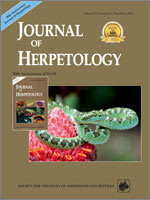Ver ítem
- xmlui.general.dspace_homeCentros Regionales y EEAsCentro Regional Mendoza - San JuanEEA JunínArtículos científicosxmlui.ArtifactBrowser.ItemViewer.trail
- Inicio
- Centros Regionales y EEAs
- Centro Regional Mendoza - San Juan
- EEA Junín
- Artículos científicos
- Ver ítem
DNA Barcoding of Phymaturus Lizards Reveals Conflicts in Species Delimitation within the patagonicus Clade
Resumen
Under the DNA Barcode initiative, we used the mitochondrial locus cytochrome c oxidase I to test if this molecular marker would reliably distinguish among lizard species of the patagonicus clade of Phymaturus. Using 18 described species and two populations of unidentified species, we calculated intra- and interpopulation genetic distances for all operational taxonomic units and performed phylogenetic reconstructions using maximum parsimony and maximum
[ver mas...]
Under the DNA Barcode initiative, we used the mitochondrial locus cytochrome c oxidase I to test if this molecular marker would reliably distinguish among lizard species of the patagonicus clade of Phymaturus. Using 18 described species and two populations of unidentified species, we calculated intra- and interpopulation genetic distances for all operational taxonomic units and performed phylogenetic reconstructions using maximum parsimony and maximum likelihood. We identified different species that share the same barcode index number (BIN). We recorded only 12 of the 18 previously described species and one candidate species from the new population. By comparing our results with published morphological and molecular phylogenies, as well as with previous debates, we propose possible explanations for this. In some cases (such as the group with the same BIN formed by Phymaturus spurcus, Phymaturus spectabilis, Phymaturus excelsus, and Phymaturus agilis), where other authors debated the identity of the species, we suggest that the low genetic distances could be attributable to the presence of one species with high polymorphism. On the other hand, in geographically isolated species such as the group formed by Phymaturus payuniae and Phymaturus nevadoi, the group formed by Phymaturus somuncurensis and Phymaturus ceii, and the group formed by Phymaturus indistinctus and Phymaturus videlai, the topology of the phylogenetic trees indicates that the low genetic distances (also found by other authors analyzing cytochrome b) could be attributable to shared ancestral polymorphism resulting from incomplete lineage sorting.
[Cerrar]

Autor
Corbalán, Valeria;
Debandi, Guillermo Oscar;
Scolaro, José Alejandro;
Ojeda, Agustina A.;
Fuente
Journal of Herpetology 50 (4) : 654-666. (2016)
Fecha
2016-12
Editorial
Society for the Study of Amphibians and Reptiles
ISSN
0022-1511
1937-2418
1937-2418
Formato
pdf
Tipo de documento
artículo
Palabras Claves
Derechos de acceso
Restringido
 Excepto donde se diga explicitamente, este item se publica bajo la siguiente descripción: Creative Commons Attribution-NonCommercial-ShareAlike 2.5 Unported (CC BY-NC-SA 2.5)
Excepto donde se diga explicitamente, este item se publica bajo la siguiente descripción: Creative Commons Attribution-NonCommercial-ShareAlike 2.5 Unported (CC BY-NC-SA 2.5)

